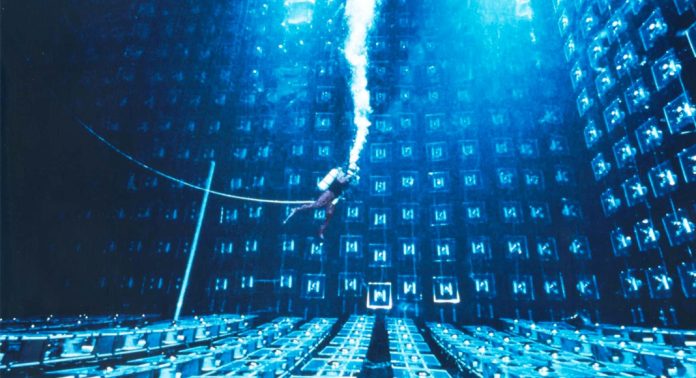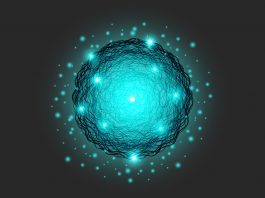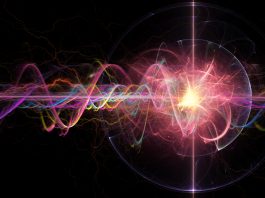Henry W Sobel from the University of California, Irvine discusses how the study of atmospheric neutrinos leads to the discovery of neutrino mass.
Earth’s atmosphere is bombarded by an isotropic flux of cosmic rays, primarily protons, which extend to very high energies. These primary cosmic rays interact with the components of the atmosphere and produce K, π and μ mesons, which in turn decay to produce so-called ‘atmospheric neutrinos’.
In a 1961 paper entitled ‘On high energy neutrino physics in cosmic rays’, Markov and Zheleznykh, from the Lebedev Institute in Moscow, discussed the possibility of detecting these neutrinos by placing a large detector deep underground, and in addition selecting those events that come from the lower hemisphere, thereby excluding the secondary cosmic ray background, primarily muons, which would come from above. The detection would be via the muons that would be produced both in the detector and in the surrounding material by the neutrino’s nuclear interaction: νμ + n → p + μ-.
Lee and Yang first calculated the detailed cross section for this process in 1960, but the actual discovery of the muon neutrino was not to be until 1962.
In 1962, Fred Reines, who was known for the first experimental observation of neutrinos (from a reactor), met Markov at the International Conference on High-Energy Physics at CERN, where they discussed the 1961 paper and the prospects for atmospheric neutrino experiments. The interest heightened in 1963 when Reines heard of a thesis by P V Ramana Murthy from the Tata Institute of the University of Bombay. In it, he demonstrated that the flux of the secondary cosmic rays produced in the atmosphere, the muons, was reduced enough in a deep mine to make the detection of the atmospheric neutrinos possible.
After first consulting with the group at the Tata Institute, Reines was eventually made aware of the very deep gold mines in South Africa and a collaboration was formed with his group from the Case Institute of Technology and the group of J P F Sellschop of the University of the Witwatersrand. Thus, two experiments were initiated, one in India led by M G K Menon at the mines of the Kolar Gold Field, and the other at the East Rand Proprietary Mine near Johannesburg. The experimental idea was similar: select those events that were coming from the horizontal or upward directions to eliminate the downward-going cosmic ray muon background.
The CASE-WITS experiment was at a depth of 3,200m (8,800m of water equivalent) and consisted of two parallel vertical walls containing 20 tons of liquid scintillator. The walls were subdivided into a crude hodoscope to determine the zenith direction of the through-going muon. They observed seven events with a cosmic ray background estimated to be less than one.
The Kolar experiment was at a depth of 2,300m (7500 mwe) and consisted of two vertical walls of plastic scintillator. The walls were also divided into elements which similarly formed a hodoscope to determine the zenith angle of the through-going muons. They observed three events, only 6% of which could be attributed to cosmic ray muons. Both experiments published these initial results in 1965 and the observation of atmospheric neutrinos was established.
The final paper from the CASE-WITS experiment had about 170 events which were used to determine that the observed neutrino flux was about 40% less than what was expected. They concluded that this was a fair agreement given the uncertainties in the prediction but, in hindsight, this was the first hint of a muon neutrino deficit.
The Grand Unified Theory
In 1974, Georgi and Glashow attempted to continue the unification of electromagnetism and the weak interaction with the additional proposed unification with the strong interaction. This, so-called, Grand Unified Theory, SU(5), predicted that the proton would decay and that the rate of that decay could be calculated. That calculated rate was fast enough that an experiment of reasonable cost could be designed and built to search for it.
A competition was initiated around the world to search for the predicted decay and thereby confirm or refute this new theory. The Irvine-Michigan-Brookhaven (IMB) water Cherenkov detector was the largest of the experiments to be built at that time. The 8,000-metric tonne detector, consisting of a rectangular tank filled with purified water and instrumented with light sensitive photomultiplier tubes, was constructed underground in the Morton Salt Mine near Fairport, Ohio. It was completed in 1981, and in 1983 the collaboration published results ruling out the SU(5) theory. The major background to the search for proton decay was the interaction of atmospheric neutrinos in the detector. The products of the interaction can match the energy and topology of the products expected from proton decay. Thus, the measurement of the atmospheric neutrino flux is of crucial importance in the experiment and the search for proton decay and the measurement of the atmospheric neutrino flux are intermingled.
A calculation of the atmospheric neutrino-induced backgrounds to the nucleon decay search in IMB-1 was published in 1986. The presence of a muon decay in the event was used to identify muon neutrinos. While the data had 26% +/- 3% muon decays, the simulation predicted 34% +/-1%. The possible systematic errors were large and so the authors did not claim a conclusive disagreement.
The muon neutrino deficit and neutrino oscillations
Experiments eventually developed techniques to detect both the atmospheric muon and electron neutrinos. This was important since while the absolute flux was uncertain, the ratio of muon neutrinos to electron neutrinos produced was well known. Therefore, the ratio of the observed muon to electron neutrinos to the predicted ratio (the ratio of ratios) was free of the absolute flux uncertainty. With these new techniques, the IMB and the Kamiokande water Cherenkov detector in Japan continued to report the muon neutrino deficit while many of the different technology detectors, also originally built to search for proton decay, did not, thus complicating any consensus.
One explanation for the muon neutrino deficit was the proposed process of neutrino oscillations. Although neutrinos were originally assumed to be massless, in many of the Grand Unified Theory models neutrino masses were non-zero. It was suggested in 1992 by Maki, Nakagawa, and Sakata that neutrino oscillations could be used to search for these masses. Neutrinos produced in the weak interaction such as νe and νμ, are so-called ‘flavour states’, and are proposed to be mixtures of different definite neutrino mass states (eigenstates). As the neutrino travels, the mass states will interfere with one another and a neutrino of a definite flavour will convert to a mixture of different flavours. The probability of the oscillation depends on the neutrino energy, the distance travelled, and the mass-squared difference (Δm2) of the neutrino mass eigenstates. Thus, a neutrino born as a muon neutrino can be converted into another flavour as a function of distance. If the detector is insensitive to the other flavour it would appear as if the muon neutrino simply disappeared.
Super-Kamiokande
The experimental situation remained controversial until the 50-kton Super-Kamiokande water Cherenkov detector was built and reported data in 1998. The detector is sensitive to a wide range of neutrino energies and has very large data samples. The large samples make it possible to finely bin the events in energy and direction. When a high energy muon or electron neutrino interacts in the detector, the lepton that is produced, a muon or an electron, preserves the direction of the incoming neutrino. Since the neutrinos originate isotopically in the Earth’s atmosphere, the direction of the in-coming neutrino is correlated with the path length it took in traversing the Earth and the atmosphere to get to the detector. Thus, neutrinos coming from the other side of the Earth have travelled about 13,000km while those produced overhead have travelled only 10s of kms. Thereby, by binning the events in zenith angle, we are binning in neutrino path length.
Data showed that those events with the shortest path lengths (down-going), agreed with the theoretical flux predictions while those coming from the other side of the Earth (up-going), with the longest path lengths, showed a significant deficit from predictions. Finally, there was definitive proof of the deficit, independent of absolute predictions. The path length of those events with the maximum deficit and the magnitude of the deficit gave the numerical parameters of the oscillation effect.
Subsequent to this reported result, the experimental landscape exploded, with ‘long-baseline’ neutrino experiments being built around the world, producing neutrino beams aimed at detectors far enough away to see the oscillation effect and with beams well enough understood to measure the oscillation numerical parameters more precisely.
Please note, this article will also appear in the fifth edition of our quarterly publication.









